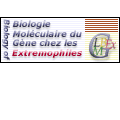
|
|















|
International Summer School
From Genome to Life:
Structural, Functional and Evolutionary approaches
|
VOGEL
Christine |
|
MRC Laboratory of Molecular Biology, Structural Studies, Hills RD, Cambridge CB2 2QH, United Kingdom title: The Evolution of Protein Families &endash; A Comparative Study on The Immunoglobulin Superfamily Repertoire in Drosophila melanogaster and Caenorhabditis elegans One of the major questions in evolutionary structural biology is how the differences in physiological complexity between organisms are reflected at the level of proteins and protein families. Proteins consist of domains, which are evolutionary and structural units. We characterised one of the largest protein families, the immunoglobulin superfamily (IgSF), in the two metazoan organisms Drosophila melanogaster (fruitfly) and Caenorhabditis elegans (worm). Despite proteomes of comparable size (Rubin et al., 2000), these two organisms differ greatly in physiological complexity, for example, of the nervous system and the number of different cells. The IgSF domains in Drosophila and worm were identified using a library of Hidden Markov Models (SUPERFAMILY, Gough, 2002) based on the sequences of domains in the Structural Classification of Proteins (SCOP) Database (Murzin et al., 1995). We also assigned other structural and sequence domains, signal sequences, low complexity regions and transmembrane helices. We identified homology amongst the IgSF proteins within and between the two organisms according to similarity in sequence, domain architecture and function. This approach allowed us to characterise the extent to which genes are conserved or specific across the two organisms. We also found cases in each of the two organisms where an expansion of gene types occurred by gene duplication and cases where genes where modified in terms of function and acquisition of new domains. The set of IgSF proteins in the fruitfly is about one-and-a-half times the size of the set in the worm (95 and 67 proteins, respectively, excluding 59 and 23 short fragments). The proteins belong to the same broad functional categories: two thirds of the fly proteins and about half of the worm proteins are involved in neural development, another fifth are involved in other developmental processes, and about one tenth are involved in muscle function in both organisms. The vast majority of proteins is common to both organisms: two thirds of the fly proteins are shared with four fifths of the worm proteins &endash; most of which are involved in development. Our findings demonstrate how the higher complexity of, e.g., the fly nervous system has evolved: The number of fly proteins within one functional group of shared proteins expanded especially in neural development, and the development and function of muscles; furthermore, two thirds of the proteins specific to the fly, but only one tenth of the proteins specific to the worm are involved in neural development. However, both organisms also developed a set of proteins with specific and novel domain combinations and functions showing an independent evolution of the IgSF after the separation of the worm and fly progenitors. We provide clues as to the function of 71 uncharacterised proteins in total based on our study of domain architecture and hence double the number of IgSF proteins with some degree of functional annotation. Thus our case study of this particular superfamily contributes to our understanding of the conservation and divergence amongst cell adhesion, development and muscle proteins of metazoan genomes. References:
|
|
ADDITIONAL DATA |
|
http://www.mrc-lmb.cam.ac.uk/genomes/cvogel/Dmig/ Pictures from the summer school / Cargese online: http://www.mrc-lmb.cam.ac.uk/genomes/cvogel/Bildchen/corsica.html
|